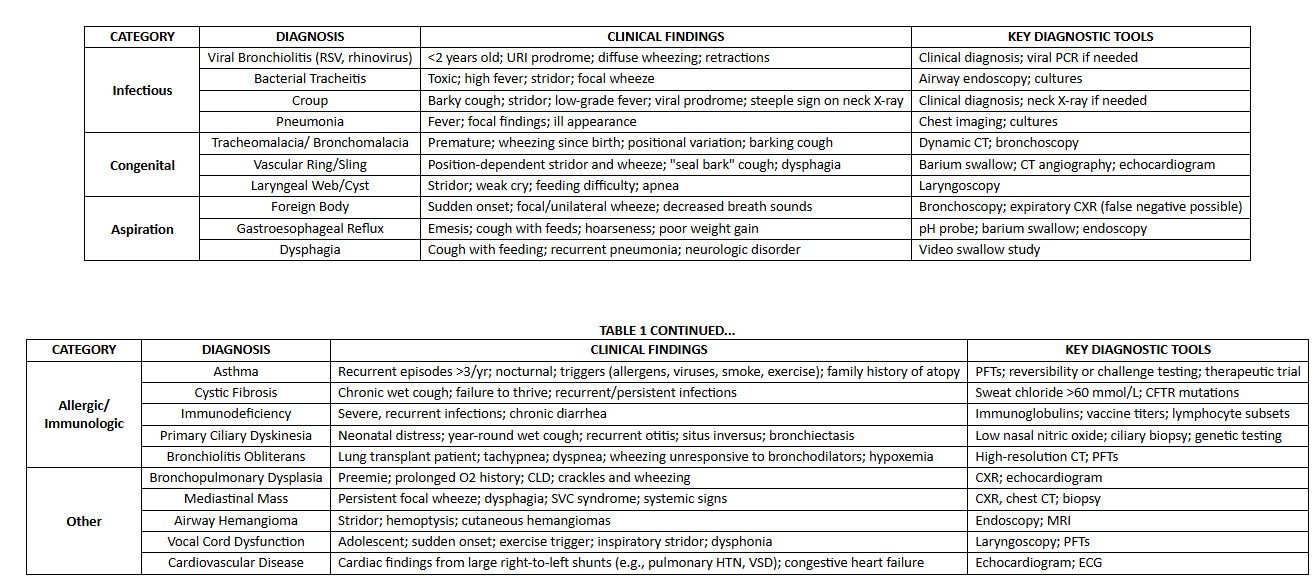TOPIC 48: Wheezing – Know the differential diagnosis of wheezing
OFFICIAL ABP TOPIC:
Know the differential diagnosis of wheezing
BACKGROUND
Wheezing refers to a continuous, high-pitched whistling sound produced by turbulent airflow through narrowed airways during breathing. Children are more prone to wheezing than adults because their airways are smaller in diameter and more compliant, making them susceptible to narrowing from inflammation, external compression, or obstruction. Identifying the underlying cause of wheezing is crucial for appropriate management.
DIFFERENTIAL DIAGNOSIS OF WHEEZING
The table below organizes key wheezing etiologies in children with distinguishing clinical features and diagnostic modalities.
TABLE 1 (DIFFERENTIAL DIAGNOSIS)
DIAGNOSTIC APPROACH TO WHEEZING
KEY HISTORICAL POINTS
- Clarify that the child is truly wheezing and not congested or stridulous.
- Determine age at symptom onset.
- Characterize temporal pattern (constant vs intermittent, acute vs chronic).
- Identify provoking factors (URIs, feeding, positioning, environmental triggers).
- Inquire about associated symptoms (cough, choking, dyspnea, vomiting, failure to thrive).
- Assess response to prior therapies (bronchodilators, steroids).
FOCUSED PHYSICAL EXAM
- General status (vital signs, growth parameters, appearance).
- Respiratory findings (work of breathing, retractions, wheezing quality).
- Focal lung signs (crackles, decreased breath sounds, bronchial breath sounds).
- Chronic lung disease stigmata (clubbing, cyanosis).
- Cardiac and upper airway assessment.
- Allergic disease signs (nasal polyps, eczema).
RED FLAGS WARRANTING URGENT EVALUATION
- Hypoxemia.
- Toxic appearance.
- Persistent or positional wheezing.
- Failure to thrive.
DIAGNOSTIC TESTING
Testing should be tailored based on leading diagnoses:
- Chest X-rays: Screen for hyperinflation, atelectasis, infiltrates, masses, foreign bodies.
- Pulmonary function tests: Evaluate obstruction and reversibility; consider bronchoprovocation.
- Flexible bronchoscopy: Visualize airways; obtain lavage/biopsy.
- Sweat chloride: Screen for cystic fibrosis; chloride >60 mmol/L highly suggestive.
- Upper GI studies: Assess aspiration, reflux, strictures, extrinsic compression.
- Echocardiogram: Evaluate cardiac structure/function; screen for vascular anomalies.
- CT angiography: Delineate complex vascular or tracheobronchial anatomy.
- Bloodwork: CBC with differential, immunoglobulins, genetic tests as indicated.
REFERENCES
https://www.uptodate.com/contents/evaluation-of-wheezing-in-infants-and-children

